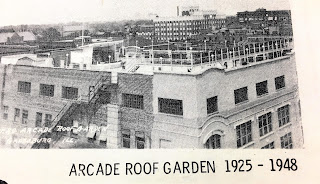“That was the beauty of the Roof Garden. If you looked over the edge, you could see people dancing in the street and on the sidewalks. The music simply floated down there from the top of the building, and a whole ‘nother dance was going on below. From above, you could gaze down on the couples and the glowing streetlights. You see, back then, even if you couldn’t afford the dance, you could still have a little of the starlight.”
This imagery of starlight comes from a novella I wrote as a companion piece to my Endurance Mysteries. Back in 2016, I published an 82-page novella about my gorgeous, smart, biracial detective, TJ Sweeney. It was called The Locket: From the Casebook of TJ Sweeney, and because it was a novella, I put it out only as an ebook. Normally, the Endurance Mysteries featured Grace Kimball, retired teacher, but for this brief moment, I decided to let her former student and detective friend, TJ, have the spotlight.
The story featured a body
found in a construction site in the present day that gave TJ a puzzle to solve. With the body was a locket and a ticket to a dance venue. It soon became apparent that this was a murder victim. Why was she killed? Who
was she? Because the bones dated back to the 1930s, it was going to be a tough
puzzle indeed—before DNA, before databases, before a lot of things. As TJ dug
into this case, it soon became personal.
I also meant this story to be a tribute to my parent’s generation. In Galesburg, Illinois, where I grew up, the Weinberg Arcade still stands, a brick-and-mortar office building downtown. During the 1930s and 1940s, however, the roof of that building became a glittering dance venue featuring the Big Bands, who toured throughout the Midwest. Tiny Hill, Lawrence Welk, Tommy Dorsey, and Paul Whiteman were just a few of the band leaders whose bands played at the Roof Garden. It was an oasis in a stormy time. My parents went there as often as possible and particularly when my dad was home from World War II.
Besides researching anecdotal accounts with Roof Garden dancers at the library archives in Galesburg, I rounded up an amazing woman who had gone to the Roof Garden when she was fourteen. She gave me detailed information and became a character named Marjorie in my novella.
“On the dance nights,
especially Saturday nights, you had to buy a ticket to get in, and it cost
twenty or twenty-five cents. It was a different time, you know. There was a
coat check guy who was Black, and an occasional musician was Black, but
otherwise the crowd was all white people. Smooching or other displays of
affection were frowned upon, and they had security guys there. But never, in
all those years, was there a fight or brawl.”
“And soldiers? Were there
soldiers?” I asked.
Another source of
information for the story was my stepmother. She had worked as a waitress in a
soda shop in downtown Galesburg in the 1930s. Years ago, she told me a
horrifying story about a racial incident where she worked. That story stayed
with me. Because The Locket has a theme about race relations in the
1930s, I included this story and put it in the mouth of TJ Sweeney’s
mother.
Two of my favorite images
from the novella came from my imagination and from my source. I pictured
soldiers milling around in their uniforms, many smoking, and waiting for the
bus to pick them up and go back to the army hospital. The second image was of
the people down on the pavement four floors below, who could clearly hear the
band music and were dancing on the sidewalks and in the streets among the hazy glow
from the streetlamps. If you couldn’t afford the price of admission, you still
could share a little stardust.
My source ended our
conversation with a wistful comment. “Eventually the war ended, and everything
changed.”
Yes, a decade later, Elvis
Presley would show up and my parent’s generation would be appalled. Now I see
why.
[Photo credit: Except for the modern-day door of the Weinberg Arcade and the book cover, all photos came from the Galesburg Public Library Archives and are use with their permission.]







What fun history to be able to include in your novella. My father had a similar experience (the dancing, not the murder) when he was in an army hospital in California recovering from shrapnel wounds.
ReplyDeleteOh, that’s cool about your dad. It was fun to go back and think about that time and what life was like then.
ReplyDeleteWhat a lovely tribute to your parents and their generation!
ReplyDeleteI love this blog so much. The imagery is so beautifully drawn.
ReplyDeletethird attempt to post. I love big band music. Great blog.
ReplyDeleteWonderful post, Susan. I can hear the music under the stars and feel my feet starting to move.
ReplyDeleteWhat a beautiful post and what a beautiful time! love this blog!
ReplyDeleteWhat a delightful backstory! My parents must have been of an age with yours. They often spoke of the dance halls in New York City. I don’t know if any were true rooftop, or simply top floor. It was a far different time. I just finished, and loved, Marry in Haste.
ReplyDeleteWell, thanks everyone. I often have people ask for another story about TJ Sweeney, but I just haven’t had time.
ReplyDeleteA tribute to the big band era and the people who sacrificed so much in WWII. So great to hear about how they still enjoyed life.
ReplyDeleteIt was a lot of fun to research, Kathleen!
ReplyDelete